"Eat
More Plants"
January 7,
2010 - Vol 2, Issue 01
| |
|
| Farmer's Market
|
|
2010
DBA
Farmer's Market The Elko DBA is
working on an annual Farmer's Market to start in July of
2010. If you interested in volunteering, becoming a
vendor, or would just like general information, email
Amber at: elkofarmersmarket
@yahoo.com
| |
|
More
Veggies
|
"Eat food, mostly
plants, not too much." This is the tag line to Michael
Pollan's book, "In
Defense of Food." His succinct advice is not a
bad one for all of us seeking new habits in our
perennial urge to start the New Year out strong and
motivated in new directions. 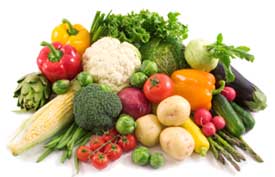 An overwhelming number of us will
make resolutions and set goals around our diet and
exercise. However, fashioning our deep desires into
action, followed by results, is a bit of a puzzle.
Success is most often realized through incremental steps
- progress with one foot in front of the other. This
issue focuses on including more plants in our diets
without any loss of flavor or satisfaction. We finish
with three scrumptious recipes that are all plant-based
and packed with delicious
nutrition. An overwhelming number of us will
make resolutions and set goals around our diet and
exercise. However, fashioning our deep desires into
action, followed by results, is a bit of a puzzle.
Success is most often realized through incremental steps
- progress with one foot in front of the other. This
issue focuses on including more plants in our diets
without any loss of flavor or satisfaction. We finish
with three scrumptious recipes that are all plant-based
and packed with delicious
nutrition.
|
Cucina Fresca's January
Clearance Specials
|

|
| January Wine of the
Month |
|
Our
annual ode to
Cowboy Poetry Month in
Elko:
WILY
JACK

Available in:
Chardonnay,
Zinfandel, and Cabernet Sauvignon
$12 a bottle
More information:
http://www.wilyjack.com/index.cfm |
| Feed a
Family |
|
Bring a
Bag and Feed a
Family!
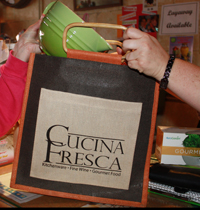 Each time you make a purchase and
bring your own bag, we will drop a dime in a jar on our
counter. All dimes collected from the jar will be
donated to the F.I.S.H. Food bank to feed Northeastern
Nevada families in need. Each time you make a purchase and
bring your own bag, we will drop a dime in a jar on our
counter. All dimes collected from the jar will be
donated to the F.I.S.H. Food bank to feed Northeastern
Nevada families in need.
With your
generous help we raised $291
throughout the holidays for the F.I.S.H Food Bank. Thank
you!
|
Upcoming
Events
|

|
E-News Drawing
|
If you
receive our newsletter, you will be entered into a
drawing each month for a great prize for your
kitchen. Check here each month to see if you have
won, if so, come in to collect your prize!
December's
winner:
Laura Kelly
Congrats, Laura, come by anytime to
pick up your
prize!
| | |
|
Shifting Eating
Habits
|
|
Whatever the reason behind your desire to shift your
eating habits, it's a great opportunity to rediscover the
pleasures of good times in the kitchen and the taste of real
food.
Without
getting too complex or controversial, nutritionists'
recommendations seem to unanimously point us in the following
directions: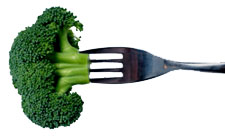
- Eat more fruits and vegetables
- Eat less saturated fat
- Consume less sugar
- Eat more whole
grains
Perhaps
your health provider has added a few more bullets to this
list?! Moving toward these nutritional targets is often
vexing and guilt-ridden. However, we prefer to take the
attitude of "adventure" and "curiosity" - the very mindset
that characterizes someone interested in cooking and eating
well!
Remodeling
Recipes and Menus
Whether your health strategy
focuses on trying new things or remaking old recipes more
healthy, here are some tips for remodeling some of your
cooking habits:
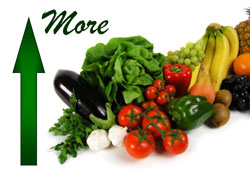 Eat
more fruits and vegetables Eat
more fruits and vegetables
- Try planning your menu around
the vegetable first, then determine the meat or protein
source; the shift in focus mirrors the change in nutritional
emphasis
- Expand your repertoire of
vegetable favorites; experiment with one new vegetable a
week; choose local, in-season foods whenever possible to
optimize cost with freshness
- Choose a serving of fruit
whenever a "sweet craving" arises; it's harder to overeat
fruit than it is most snack foods
- Opt for whole fruits instead
of fruit juices for an increased sense of fullness, slower
digestion, and the extra
fiber
 Eat
less saturated
fat Eat
less saturated
fat
- Generally, choose plant-based
fats instead of animal-based fats
- Use olive oil instead of
butter wherever possible
- Use egg whites instead of
whole eggs for all or part of the eggs in a recipe
- Opt for olive oil-based salad
dressings as opposed to creamy dressings
- Choose lower fat, or reduced
fat dairy products
- Cut the quantity of butter or
cheese in half wherever it will not impact the chemistry of
the recipe
Consume
less sugar
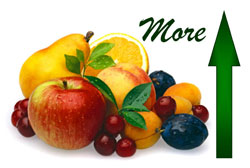 Choose
fruit for snacks or dessert instead of sugar-laden choices
(1 cookie = 1 orange) Choose
fruit for snacks or dessert instead of sugar-laden choices
(1 cookie = 1 orange)
- Beware of foods that have
"high-fructose" sugars on the ingredient list
- Eat the whole fruits instead
of their juice counterparts or "fake" juices
- Experiment with substituting
applesauce for sugar in baking recipes
- Eat semi-sweet or bittersweet
chocolate instead of milk chocolate
- Keep your favorite sweet
indulgence part of your diet in appropriate portions; too
much perceived denial may backfire in the long
run
 Eat
more whole
grains Eat
more whole
grains
- Substitute whole wheat flour
for at least half of the flour in most recipes
- Enjoy the nutty flavor of
whole grain brown rice instead of white rice
- Get acquainted with
quick-cooking whole grains, for example, oats or
quinoa
Beware of
processed foods even when they're touted as healthy or
low-calorie. A vast amount of our food choices are
manufactured, altered, or processed in ways that have become
distant from their origins and may not do us that much
good.
Choosing Complete Proteins -
The body
requires twenty different amino acids to form proteins that
comprise new cells, enzymes, body tissue and promote overall
health. The body can manufacture twelve of these building
blocks, but must be fed the other eight. These eight amino
acids are known as the essential amino acids. With a couple of
exceptions, (soy and quinoa), individual plants do not possess
all eight amino acids as animal products do. However, by
combining different plant foods, the necessary array of amino
acids is achieved and the body is adequately nourished. The
key is to eat a variety of plant foods and combine
complementary sources. 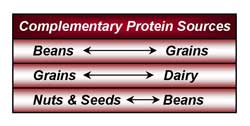 For example, the amino acid profile in
beans and grains complement each other, dairy complements
grains, and beans complement nuts and seeds. It is not
necessary to eat complementary foods at each meal, but rather,
recent research reveals that a variety of complementary foods
over a twenty-four period is just as
effective. For example, the amino acid profile in
beans and grains complement each other, dairy complements
grains, and beans complement nuts and seeds. It is not
necessary to eat complementary foods at each meal, but rather,
recent research reveals that a variety of complementary foods
over a twenty-four period is just as
effective.
|
Cooking
Grains
|
Grains
are a staple of any diet and possess great nutritional value
and efficiency. As you explore eating choices and healthy
foods, grains deserve a central role in your cooking
repertoire. Not only do they complement legumes and dairy
products for a complete protein, they provide essential
vitamins and minerals in abundance. If you're concerned about
the carbohydrates in grains, know that whole grains are
complex carbohydrates and full of important dietary fiber;
keep the grains, ditch the sugar if you're worried about
carbs.

Get Comfortable with Cooking
Grains - Grains come in all forms, whole, cracked,
parboiled, and re-formed. The less processed the grain, the
greater the nutritional value. Kernels should be cooked just
until tender, and have a fluffy character, without stickiness.
To achieve this result, care must be taken with (1) the ratio
of water to grain, and (2) achieving a low, even cooking
temperature.
Prepping Grains for Cooking - For whole
grains and those purchased in bulk, rinse the grain in a
colander prior to cooking. This removes any dust and helps to
expose any foreign particles.
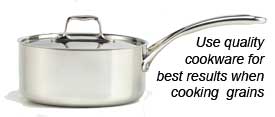
Low,
Even Cooking Temperature - The key to perfectly cooked
grain is a good cooking pot and very low simmering
temperatures. A good cooking pot starts with a heavy-bottom,
sturdy conductive walls, an ergonomic handle, and a
well-fitting lid. The heavy-bottom will conduct heat evenly
across the contact surface and up the walls. A tight lid
will keep the steam inside the pot doing its work on the
grain. We carry several quality lines of cookware. When you
come by the shop, we'll acquaint you with the key factors to
consider when buying good cookware.
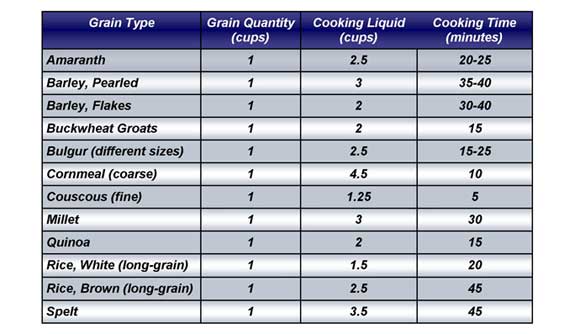
Testing for Doneness - Beyond
these general starting points, cooking will vary depending on
the size of the grain pieces, the cooking pot, and actual
temperatures. Time the cooking so that the grain is checked
only as it nears its finish. (Too much checking will release
too much steam). With a utensil, check the bottom of the
pan to assess if any grain is sticking. Test for doneness by
tasting a few grains from the top. Ideally, the cooking water
should be absorbed just as the grain reaches the right
tenderness. If the grain is cooked, but water remains, drain
the grain in a colander, return to the pan and let it sit 5-10
more minutes with the lid on to allow any residual moisture to
be absorbed. If the water is gone, but the grain still not
tender, add more water in small increments.
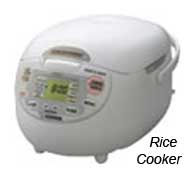 Rice Cookers - Rice cooking
appliances may be used to cook all types of grains. Rice
cookers eliminate the need for a watchful cook. The cooker
quickly heats the water and grain, reduces the power to the
perfect simmer, then automatically turns off power or shifts
to a warming mode just as the liquid is absorbed and the
grains become tender. Rice Cookers - Rice cooking
appliances may be used to cook all types of grains. Rice
cookers eliminate the need for a watchful cook. The cooker
quickly heats the water and grain, reduces the power to the
perfect simmer, then automatically turns off power or shifts
to a warming mode just as the liquid is absorbed and the
grains become tender.
Grains in a Slow Cooker -
Grains may be cooked in a slow cooker by using the same
quantities of grain and liquid noted above and allowing 6-8
hours of undisturbed
cooking.
|
Cooking
Beans
|
 Beans are a great source of nutrition and
a good cornerstone for a a more plant-based diet. Starting
with dried beans offers nutritional and economic value, and
they taste infinitely better than their canned counterparts.
Learning a few key techniques will get you comfortable with
using dried beans and reaping all of their advantages. Beans are a great source of nutrition and
a good cornerstone for a a more plant-based diet. Starting
with dried beans offers nutritional and economic value, and
they taste infinitely better than their canned counterparts.
Learning a few key techniques will get you comfortable with
using dried beans and reaping all of their advantages.
 Soaking
Beans - Soaking dried beans begins the softening
process and allows the beans to cook more evenly on the
stovetop. (If you use a pressure cooker to cook beans, no
soaking is necessary). Beans will triple in size as they
rehydrate, so choose a soaking pot that will accommodate this
amount of swelling; use a general ratio of 1 cup dry beans to
5 cups water. First, rinse your dried beans in a colander and
look them over to discard any foreign particles and any
discolored or shriveled beans. Soak the beans in one of two
ways: Soaking
Beans - Soaking dried beans begins the softening
process and allows the beans to cook more evenly on the
stovetop. (If you use a pressure cooker to cook beans, no
soaking is necessary). Beans will triple in size as they
rehydrate, so choose a soaking pot that will accommodate this
amount of swelling; use a general ratio of 1 cup dry beans to
5 cups water. First, rinse your dried beans in a colander and
look them over to discard any foreign particles and any
discolored or shriveled beans. Soak the beans in one of two
ways:
- Hot
Soaking - Heat 10 cups of water to boiling, add two
cups (1 pound) of dried beans and boil for 2 to 3
minutes. Remove from the heat source, cover, and let
set for one to four hours.
- Overnight
Soaking - Using no heat, place two cups of dried
beans in 10 cups of cold water. Allow the beans to set
overnight or for at least 8 hours.
Boiling the Beans - Drain the
soaking water from the beans and rinse. Add fresh, unsalted
water to cover the beans and bring to a boil over high heat
for a few minutes. Reduce the heat to medium and cook at a
full simmer until beans are tender to the bite. Different
beans will vary in the time required for boiling according to
their shape, "thickness," and age. Older beans will take
longer to cook. Beans are done when the outside skin is still
intact, but the bean 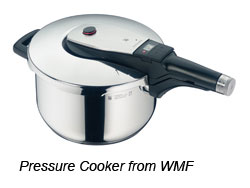 smashes easily when squished with
a fork. smashes easily when squished with
a fork.
Pressure
Cooking Beans - Alternatively, cook beans in a pressure
cooker. It turns them into "fast food" allowing beans to be
part of everyday menus as opposed to some periodic, heroic
effort. With pressure cooking, no soaking is required.
Beans in a Slow Cooker -
Experts recommend cooking soaked beans in a slow cooker on a
high setting for 2-3 hours taking care that they remain
immersed in liquid as they swell and absorb the moisture.
After this period, turn the beans to a low setting and allow
them to cook for 6 to 8 hours. Slow cookers are great for
preparing all kinds of bean
dishes.
|
Cucina Fresca's Healthy Eating
Tips
|
 Tip #1: Cook double
(or triple) batches of grains whenever cooking. Cooked grains
will refrigerate and freeze well if stored with minimal air
exposure. We find a plastic zipper bag with the air squeezed
out keeps the grain from drying out. Freeze cooked grain in
logical quantities; defrost in a microwave or steamer with the
addition of a small amount of water. Tip #1: Cook double
(or triple) batches of grains whenever cooking. Cooked grains
will refrigerate and freeze well if stored with minimal air
exposure. We find a plastic zipper bag with the air squeezed
out keeps the grain from drying out. Freeze cooked grain in
logical quantities; defrost in a microwave or steamer with the
addition of a small amount of water.
Tip #2: Keep cans or
boxes of purchased vegetable stock in the pantry for cooking
grains. Grains cooked in stock have a fantastic taste. In most
cases, the salt present in the stock is enough for the grain.
If stock is used, omit adding any additional
salt.
Tip
#3: Mash cooked beans with a pastry cutter
instead of a potato masher; this helps to cut the outer skin
surrounding the bean. Mashed beans can be turned into a quick
sandwich spread with a few spices and herbs.
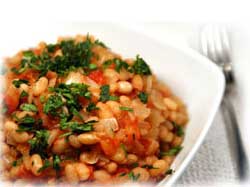 Tip #4: Salt toughens
the outer skin of beans making them less permeable to water,
and lengthening the time it takes to cook. Add salt to beans
only after they are cooked to the desired
tenderness. Tip #4: Salt toughens
the outer skin of beans making them less permeable to water,
and lengthening the time it takes to cook. Add salt to beans
only after they are cooked to the desired
tenderness.
Tip
#5: Refrigerate cooked beans in their liquid for
up to 5 days. The liquid will help prevent the beans from
drying out. Cooked beans may be frozen for 2 to 3 months and
can be easily reheated. Boil up a big batch of beans and
package them in convenient sizes for later
use.
|
Q &
A's
|
 Q: What is tofu? Q: What is tofu?
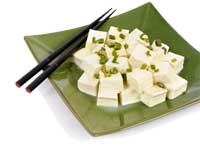 A: Tofu is a
coagulated form of soy milk. What cheese is to milk, tofu is
to soy milk. Tofu is white in color and bland in flavor. It is
nutritionally dense with a high protein, iron, and calcium
content. Like cheese, based on the amount of moisture drained
from the tofu, it can vary in texture and firmness. Tofu,
while often unfamiliar to a lot of us, is worth exploring. As
a soy product, tofu provides a complete protein
source. A: Tofu is a
coagulated form of soy milk. What cheese is to milk, tofu is
to soy milk. Tofu is white in color and bland in flavor. It is
nutritionally dense with a high protein, iron, and calcium
content. Like cheese, based on the amount of moisture drained
from the tofu, it can vary in texture and firmness. Tofu,
while often unfamiliar to a lot of us, is worth exploring. As
a soy product, tofu provides a complete protein
source.
Q: What
is quinoa?
A: Quinoa, (pronounced
"keen'-wah," or "keen'-oh-ah"), is actually related to beets
and spinach, and not a true grass like other grains. It is
gluten-free, easily digestible, possesses a complete protein
complement and is quick cooking. Quinoa is naturally covered
with a coating of bitter saponin. This bitterness keeps it
from being eaten by birds while in the field. To remove the
saponin, simply soak quinoa for a few minutes and rinse prior
to cooking. Much of the commercially available quinoa comes
pre-rinsed with the saponin already removed.
Q: Are there official
definitions for the health claims on food
packaging?
A: According to the
American Dietary Association, there are specific
qualifications that a food must attain before claiming certain
designations:
- "Free,"
(fat-free, sugar-free, etc.), is defined as an amount so
small that it would not have an effect on the body.
- "Light/Lite"
designates a food with one-third fewer calories or 50% less
fat than standard versions of the food.
- "Reduced,"
(reduced calories, reduced fat, etc.), indicates that the
food has at least 25% less than a comparable food.
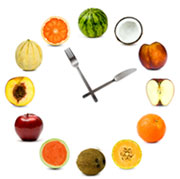
- "Good
Source" means that the item has 10-19% of the
recommended daily value of the cited nutrient.
- "Healthy"
marks foods that are low in saturated and unsaturated fats
and meets specific levels of cholesterol, sodium, and other
vitamins and
minerals.
Q: Where can I find the time to do
healthy cooking?
A:
"I have to hurry up and get supper ready so that
I can get a little relaxation in this evening." Make
cooking a pleasurable event and not a task. Cooking can be
relaxing, an art form, and a creative outlet that reenergizes
your body and spirit. We're here to help you develop this
mindset!
|
Cookbook
Review
|
How to
Cook Everything Vegetarian, Simple Meatless Recipes for
Great Food by Mark Bittman. Illustrations by Alan Witschonke.
Copyright 2007. Published by Wiley Publishing, Inc., Hoboken,
NJ.
An IACP
Cookbook Award Winner
Mark Bittman never
tackles a subject without being thorough. We thought a
previous title of his, "How
to Cook Everything," pretty much covered everything,
but Mark has created yet another encyclopedic book covering,
as promised, just about everything vegetarian in its 996
pages. While the hefty book may be initially intimidating,
inside the subject matter is easily digestible and presented
accessibly. 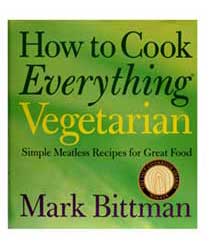 Mr. Bittman takes an apolitical
approach to the topic of vegetarianism, but exudes an energy
around the vast possibilities available in a vegetarian or
flexitarian kitchen. The cookbook begins with an enabling
introduction for approaching vegetarian cooking, then delves
right into Salads, Soups, Eggs, Dairy and Cheese, followed by
Produce, Pasta, Grains, and Legumes. He finishes with chapters
on Breads of all kind, Sauces and Condiments, and wraps up
with Desserts. True to "Bittman-style," each chapter begins
with an informative context packed with technique and basics
that the recipes build upon. Generous sidebars of information
offer hints for variations, illustrated techniques, or tips
for achieving success. The book is an endless resource of
information suitable for any vegetarian or
flexitarian! Mr. Bittman takes an apolitical
approach to the topic of vegetarianism, but exudes an energy
around the vast possibilities available in a vegetarian or
flexitarian kitchen. The cookbook begins with an enabling
introduction for approaching vegetarian cooking, then delves
right into Salads, Soups, Eggs, Dairy and Cheese, followed by
Produce, Pasta, Grains, and Legumes. He finishes with chapters
on Breads of all kind, Sauces and Condiments, and wraps up
with Desserts. True to "Bittman-style," each chapter begins
with an informative context packed with technique and basics
that the recipes build upon. Generous sidebars of information
offer hints for variations, illustrated techniques, or tips
for achieving success. The book is an endless resource of
information suitable for any vegetarian or
flexitarian!
|
Three Plant-based
Recipes
|
Recipes excerpted from How to
Cook Everything Vegetarian by Mark Bittman. Published
by Wiley Publishing, Inc., Hoboken, NJ. Copyright 2007.
Reprinted with permission of the publisher. All rights
reserved.
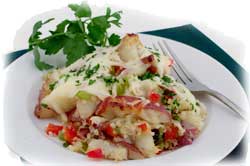 Roasted
Quinoa with Potatoes and Cheese Roasted
Quinoa with Potatoes and Cheese
As promised, the
cooked and roasted quinoa created a nutty flavor and coating
on the potato wedges. The inclusion of savory scallions and
peppers added just the right touch of flavor. The dish went
together quickly and tasted fantastic. It made a great main
dish and a complete meal with the addition of a mixed greens
salad.
Click here to view the
illustrated recipe.
Click here for a
printable
version of the recipe.
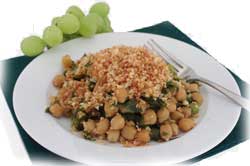 Beans
and Green Beans
and Green
Simple and satisfying, this "beans and
greens" dish had amazing flavor! We cooked dried chickpeas in
a pressure cooker in no time, and allowed the greens (kale
instead of broccoli raab) to become silky and tender. Cooking
dried chickpeas was much preferable to canned versions. This
is a great basic recipe for experimenting with variations of
other beans and other greens.
Click here to view the
illustrated recipe.
Click here for a
printable
version of the recipe.
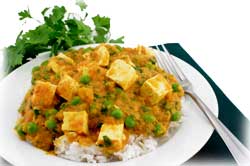 Braised
Tofu and Peas in Curried Coconut Milk Braised
Tofu and Peas in Curried Coconut Milk
At the
risk of stereotyping vegetarian cooking, we couldn't help but
include one tofu recipe! The Indian-inspired flavors blended
together in a great curried gravy. The tofu soaked up the
piquant flavors and along with a fragrant bed of basmati rice
turned the kitchen into an aromatic heaven.
Click here to view the
illustrated recipe.
Click here for a
printable
version of the
recipe.
| |
To home
and hearth, to health and wealth, Best Wishes for a Happy New
Year!
|
|
| |